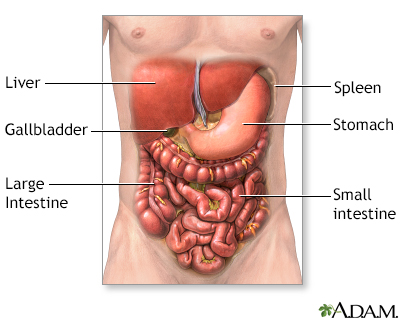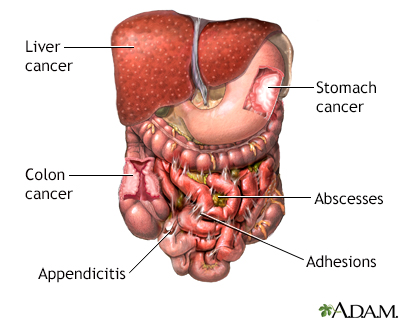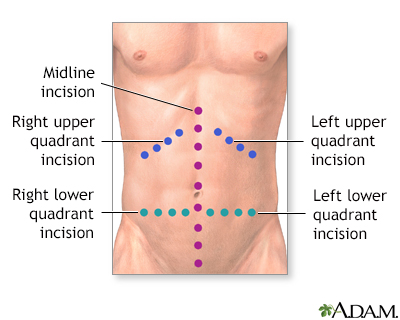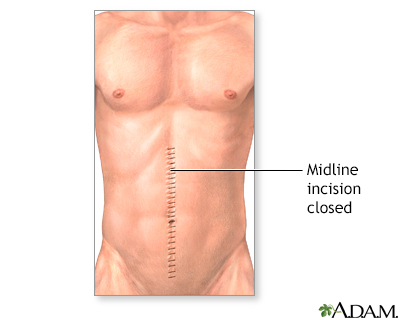Abdominal exploration
Normal anatomy
|
|
The abdomen contains many vital organs: the stomach, the small intestine (jejunum and ileum), the large intestine (colon), the liver, the spleen, the gallbladder, the pancreas, the uterus, the fallopian tubes, the ovaries, the kidneys, the ureters, the bladder, and many blood vessels (arteries and veins).
|
Indication
|
|
The surgical exploration of the abdomen, also called an exploratory laparotomy, may be recommended when there is abdominal disease from an unknown cause (to diagnose), or trauma to the abdomen (gunshot or stab-wounds, or "blunt trauma").
Diseases that may be discovered by exploratory laparotomy include:
- Inflammation of the appendix (acute appendicitis)
- Inflammation of the pancreas (acute or chronic pancreatitis)
- Pockets of infection (retroperitoneal abscess, abdominal abscess, pelvic abscess))
- Presence of uterine tissue (endometrium) in the abdomen (endometriosis)
- Inflammation of the Fallopian tubes (salpingitis)
- Scar tissue in the abdomen (adhesions)
- Cancer (of the ovary, colon, pancreas, liver)
- Inflammation of an intestinal pocket (diverticulitis)
- Hole in the intestine (intestinal perforation)
- Pregnancy in the abdomen instead of uterus (ectopic pregnancy)
- To determine the extent of certain cancers (Hodgkin's lymphoma)
|
Procedure
|
|
While the patient is deep asleep and pain-free (general anesthesia), the surgeon makes an incision into the abdomen and examines the abdominal organs. Different incisions are sometimes used depending on the circumstance. Common incisions include a vertical midline incision, and right or left upper or lower quadrant transverse incisions. Tissue samples (biopsies) can be taken and diseased areas can be evaluated. When the treatment is complete, the incision is closed with either sutures or skin staples.
|
Aftercare
|
|
The outcome from surgery varies with the disease process, as does the course and duration of recovery. Exploratory laparotomy is most commonly performed for trauma, severe abdominal pain of unknown cause, intestinal obstruction, inflammatory diseases like appendicitis and diverticulitis, and cancer of any of the abdominal organs.
|

Review Date:2/28/2022
Reviewed By:Debra G. Wechter, MD, FACS, General Surgery Practice Specializing in Breast Cancer, Virginia Mason Medical Center, Seattle, WA. Also reviewed by David Zieve, MD, MHA, Medical Director, Brenda Conaway, Editorial Director, and the A.D.A.M. Editorial team.
The information provided herein should not be used during any medical emergency
or for the diagnosis or treatment of any medical condition. A licensed medical professional
should be consulted for diagnosis and treatment of any and all medical conditions. Call 911
for all medical emergencies. Links to other sites are provided for information only -- they
do not constitute endorsements of those other sites. © 1997-A.D.A.M., Inc. Any duplication or distribution of the information contained herein is strictly prohibited.
The Agency for Health Care Administration (Agency) and this website do not claim the information on, or referred to by, this site is error free. This site may include links to websites of other government agencies or private groups. Our Agency and this website do not control such sites and are not responsible for their content. Reference to or links to any other group, product, service, or information does not mean our Agency or this website approves of that group, product, service, or information.
Additionally, while health information provided through this website may be a valuable resource for the public, it is not designed to offer medical advice. Talk with your doctor about medical care questions you may have.




